
The Stateline Wind Farm is a wind farm located on Vansycle Ridge, which receives 16 to 18 mph average wind speeds from the Columbia Gorge, on the border between Washington and Oregon in the United States. With 454 turbines, it is the largest wind project in the Northwestern United States. Costing $300 million to build, it began operation in 2001.

Albany wind and Grasmere farms are two wind power stations near Albany, Western Australia, owned by Bright Energy Investments. They are adjacent and are often considered a single facility. They have 18 wind turbines, with a maximum generating capacity of 35.4 MW of electricity. The original Albany Wind Farm was commissioned in October 2001, after ten years of planning. The wind farm has the capacity to produce 80 per cent of the electricity requirements of Albany.
Cathedral Rocks Wind Farm is a wind power station located about 30 km west of Port Lincoln in South Australia, near the southern tip of the Eyre Peninsula. It has 33 wind turbines of 2 MW each, with a combined generating capacity of 66 MW of electricity. The site covers an area of about 29 km², with a coastal exposure of nearly 11 km and is private farming land. The wind farm was commissioned in September 2005.
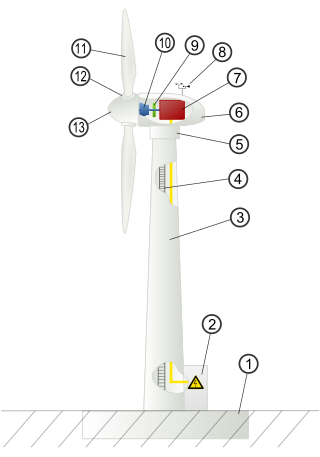
Wind turbine design is the process of defining the form and configuration of a wind turbine to extract energy from the wind. An installation consists of the systems needed to capture the wind's energy, point the turbine into the wind, convert mechanical rotation into electrical power, and other systems to start, stop, and control the turbine.
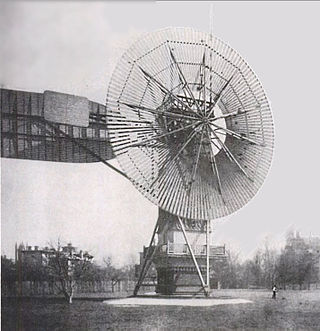
Wind power has been used as long as humans have put sails into the wind. For more than two millennia wind-powered machines have ground grain and pumped water. Wind power was widely available and not confined to the banks of fast-flowing streams, or later, requiring sources of fuel. Wind-powered pumps drained the polders of the Netherlands, and in arid regions such as the American mid-west or the Australian outback, wind pumps provided water for livestock and steam engines.
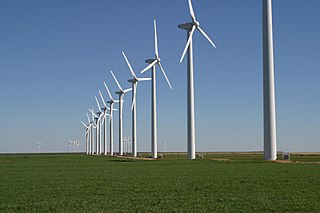
Wind power is a branch of the energy industry that has expanded quickly in the United States over the last several years. From January through December 2021, 379.8 terawatt-hours were generated by wind power, or 9.23% of electricity in the United States. The average wind turbine generates enough electricity in 46 minutes to power the average American home for one month. In 2019, wind power surpassed hydroelectric power as the largest renewable energy source in the U.S.

The Waubra wind farm is located on both sides of the Sunraysia Highway 35 km north-west of Ballarat in Victoria, Australia. Upon its completion in July 2009, it was the largest wind farm in Australia and was the largest wind farm by number of turbines and total capacity in the southern hemisphere.

The Wild Horse Wind Farm is a 273-megawatt wind farm that generates energy for Puget Sound Energy that consists of one hundred twenty seven 1.8-megawatt Vestas V80 turbines and twenty two 2.0-megawatt Vestas V80 turbines on a 10,800-acre (4,400 ha) site in Kittitas County, Washington, 17 miles (27 km) east of Ellensburg, Washington. The turbines are placed on the high open Shrub-steppe ridge tops of Whiskey Dick Mountain, which was chosen for its energetic wind resource, remote location, and access to nearby power transmission lines. The towers are 221 feet (67 m) tall, and each blade is 129 feet (39 m) long, with a total rotor diameter of 264 feet (80 m), larger than the wingspan of a Boeing 747. The turbines can begin producing electricity with wind speeds as low as 9 mph (14 km/h) and reach full production at 31 mph (50 km/h). They shut down at sustained wind speeds of 56 mph (90 km/h). The site is also home to one of the largest solar array (500 kW) in Washington.
Wind power in Ohio has a long history, and as of 2016, Ohio had 545 megawatts (MW) of utility-scale wind power installations installed, responsible for 1.1% of in-state electricity generated. Over 1000 MW more were under construction or pending approval. Some installations have become tourist attractions. There has been a sudden increase in generating capacity, as total wind power capacity in the state was just 9.7 MW in 2010. By 2019, there were 738 MW of capacity, which generated 1.71% of Ohio's electricity.

Making up over 55% of the state's generated electricity in 2021, wind power is the largest source of electricity generation in Iowa. In 2020, over 34 billion kWh of electrical energy was generated by wind power. As of Q3 2020, Iowa has over 10,951 megawatts (MW) of installed capacity with 5,590 wind turbines, ranking 2nd and 3rd in the nation below Texas respectively.

A floating wind turbine is an offshore wind turbine mounted on a floating structure that allows the turbine to generate electricity in water depths where fixed-foundation turbines are not feasible. Floating wind farms have the potential to significantly increase the sea area available for offshore wind farms, especially in countries with limited shallow waters, such as Japan, France and US West coast. Locating wind farms further offshore can also reduce visual pollution, provide better accommodation for fishing and shipping lanes, and reach stronger and more consistent winds.

Te Uku Wind Farm is a wind farm at Te Uku near Raglan, New Zealand. It has a capacity of 64MW using 28 wind turbines. Construction was completed in March 2011, at a cost of $200 million. The farm covers an area of approximately 200 hectares (2.0 km2). The wind farm is jointly owned by WEL Networks and Meridian Energy.
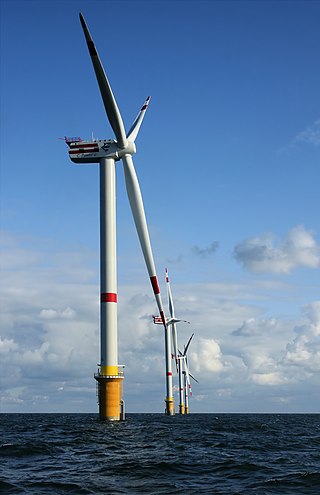
A wind turbine is a device that converts the kinetic energy of wind into electrical energy. As of 2020, hundreds of thousands of large turbines, in installations known as wind farms, were generating over 650 gigawatts of power, with 60 GW added each year. Wind turbines are an increasingly important source of intermittent renewable energy, and are used in many countries to lower energy costs and reduce reliance on fossil fuels. One study claimed that, as of 2009, wind had the "lowest relative greenhouse gas emissions, the least water consumption demands and the most favorable social impacts" compared to photovoltaic, hydro, geothermal, coal and gas energy sources.
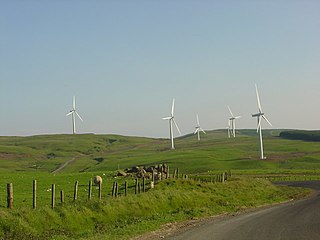
Hadyard Hill Wind Farm is located in Carrick district of South Ayrshire. Costing £85 million, the wind farm consists of 52 three-bladed Siemens wind turbines, each capable of generating 2.3 megawatts (MW) of power, giving a total output of 120 MW. This was Britain's most powerful wind farm when it was commissioned in March 2006.
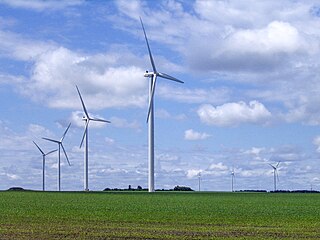
St. Leon Wind Farm is Manitoba's first wind farm, in St. Leon, Manitoba, Canada. In the first phase completed in 2006, 63 wind turbines were erected over a 93-square-kilometre (36 sq mi) area, capable of delivering 99 megawatts (MW). In 2011 a further 10 turbines were purchased, expanding the capacity of the project to 120 megawatts.

The Delabole wind farm was the first commercial onshore wind farm built in the United Kingdom, in November 1991. This field of wind turbines was initially developed by Windelectric Management Ltd.
Sere Wind Farm is a wind-farm in the Western Cape province of South Africa that is one of the largest wind-farms in Southern Africa with a production capacity of 100 MW. The project is estimated to have cost R2.689 billion. Eskom stated that the plant was fully commissioned on 31 March 2015.

Wind power in North Carolina is found along the coastal areas in the east and mountain regions in the western part of the state. The state has significant offshore wind resources. In 2015, small scale wind turbine projects were found throughout the state. In 2016, North Carolina's first large scale wind project, and the first in the southeastern U.S., was completed near Elizabeth City.

Renewable energy in South Africa is energy generated in South Africa from renewable resources, those that naturally replenish themselves—such as sunlight, wind, tides, waves, rain, biomass, and geothermal heat. Renewable energy focuses on four core areas: electricity generation, air and water heating/cooling, transportation, and rural energy services. The energy sector in South Africa is an important component of global energy regimes due to the country's innovation and advances in renewable energy. South Africa's greenhouse gas (GHG) emissions is ranked as moderate and its per capita emission rate is higher than the global average. Energy demand within the country is expected to rise steadily and double by 2025.

















